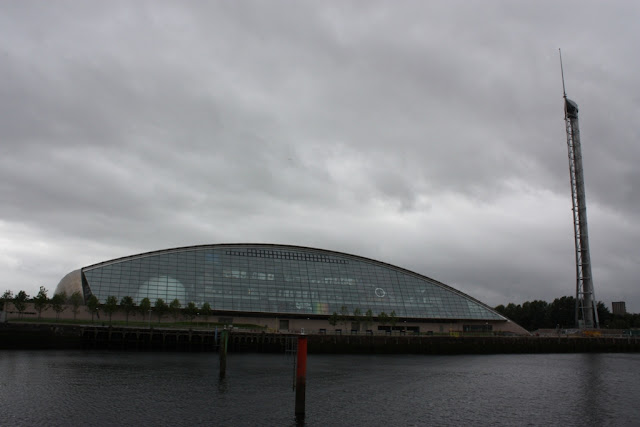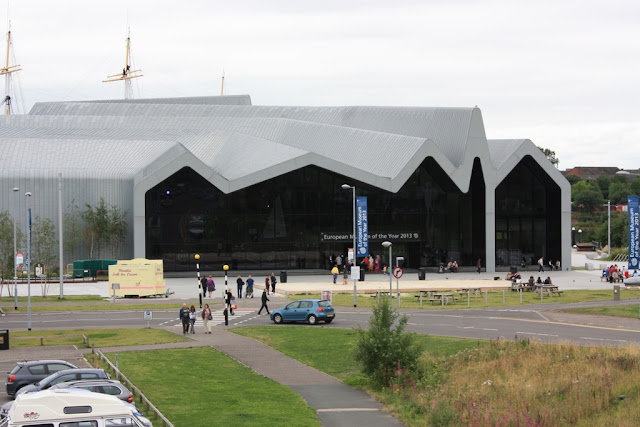Sunny this morning as we packed and left our nice little unit at the Castlecary Hotel in Cumbernauld near Glasgow heading to Whitley Bay near Newcastle upon Tyne.
In the process we bade farewell to Scotland for the last time.
There were dozens of options for getting down into England so we decided to let the GPS decide. It chose the motorway so after a bit of weaving we ended up on the M74 heading due south into England.
The GPS showed that we needn't do anything for the next140 kilometres.
We passed the exit to Gretna Green which is where young English people used to go to get married early as it is one of the first villages in Scotland.
Mick was getting a bit bored with this so decided to take the exit to Lockerbie which is where Pan Am flight 103 came down on 21 December 1988 after a bomb exploded on board showering the town with wings full of fuel. The plane had taken off from London Heathrow Airport a short time earlier.
We arrived in the town and followed signs to the Remembrance Garden on the edge of town. We parked the car and wandered into a large cemetry. Thinking we had come to the wrong place we went to a building in the corner of the cemetery where there was a sign saying Dryfesdale Lodge Visitors Centre.
It turned out that the visitors centre was originally built as a house for the cemetery caretaker and the building had become surplus to requirements by the 1990s and was standing empty. The policy of Dumfries & Galloway Council, which owns the building was to sell off unneeded cemetery lodges as private homes but it was felt by a number of local people that a private home would not be appropriate for this one being situated as it is at the entrance to the Lockerbie Air Disaster Memorial and Garden of Remembrance.
In 2003 a group of eight Trustees was formed and with money awarded by the Lockerbie Trust the building was extensively renovated and developed into a centre for the local community, visitors to Lockerbie and to the Memorial Garden. The Centre was formally opened on 25th October 2003 and is a registered Scottish Charity.
The lady there was very helpful giving us the above detailed history of the centre and describing the disaster itself and the subsequent events including the creation of the memorial.
We spent some time talking to her and looking at the interesting items in the centre including photos, a quilt with 259 leaves depicting the number of people lost in the disaster and 11 pebbles depicting the people in Lockerbie who were killed, plus many books and newspaper cuttings about the event.
We then went into the cemetery to look at the beautifully maintained memorial garden which contained a marble wall containing the names of those killed and many personal plaques placed by relatives.
When we were leaving we called in to the office to thank the lady there when Lyn saw pictures of Red Squirrels in an adjoining room. The lady said that they were taken at a wildlife centre across the road and gave us a brochure for the Eskrigg Centre. She said that if we went there we were guaranteed to see Red Squirrels.
We walked across the road through a gate and 200 metres down a path we found a hide overlooking feeders placed on trees. The varied birds which included blue tits, coal tits, robins, woodpeckers and a nuthatch were very busy flying back and forth eating. It wasn't long before a Red Squirrel appeared at the feeders and he spent some time munching away.
The manager at the centre, Jim Rae, who was a retired biology teacher, told us that on one occasion in the colder weather, there were 18 Red Squirrels around the feeders. He quietly opened some of the windows so that we could get better photographs.
It was a perfect location amongst the pines and was we'll worth the visit.
We then continued our journey and arrived at Mick's cousins house at about 3.45pm.
In the process we bade farewell to Scotland for the last time.
There were dozens of options for getting down into England so we decided to let the GPS decide. It chose the motorway so after a bit of weaving we ended up on the M74 heading due south into England.
The GPS showed that we needn't do anything for the next140 kilometres.
We passed the exit to Gretna Green which is where young English people used to go to get married early as it is one of the first villages in Scotland.
Mick was getting a bit bored with this so decided to take the exit to Lockerbie which is where Pan Am flight 103 came down on 21 December 1988 after a bomb exploded on board showering the town with wings full of fuel. The plane had taken off from London Heathrow Airport a short time earlier.
We arrived in the town and followed signs to the Remembrance Garden on the edge of town. We parked the car and wandered into a large cemetry. Thinking we had come to the wrong place we went to a building in the corner of the cemetery where there was a sign saying Dryfesdale Lodge Visitors Centre.
It turned out that the visitors centre was originally built as a house for the cemetery caretaker and the building had become surplus to requirements by the 1990s and was standing empty. The policy of Dumfries & Galloway Council, which owns the building was to sell off unneeded cemetery lodges as private homes but it was felt by a number of local people that a private home would not be appropriate for this one being situated as it is at the entrance to the Lockerbie Air Disaster Memorial and Garden of Remembrance.
In 2003 a group of eight Trustees was formed and with money awarded by the Lockerbie Trust the building was extensively renovated and developed into a centre for the local community, visitors to Lockerbie and to the Memorial Garden. The Centre was formally opened on 25th October 2003 and is a registered Scottish Charity.
The lady there was very helpful giving us the above detailed history of the centre and describing the disaster itself and the subsequent events including the creation of the memorial.
We spent some time talking to her and looking at the interesting items in the centre including photos, a quilt with 259 leaves depicting the number of people lost in the disaster and 11 pebbles depicting the people in Lockerbie who were killed, plus many books and newspaper cuttings about the event.
We then went into the cemetery to look at the beautifully maintained memorial garden which contained a marble wall containing the names of those killed and many personal plaques placed by relatives.
When we were leaving we called in to the office to thank the lady there when Lyn saw pictures of Red Squirrels in an adjoining room. The lady said that they were taken at a wildlife centre across the road and gave us a brochure for the Eskrigg Centre. She said that if we went there we were guaranteed to see Red Squirrels.
We walked across the road through a gate and 200 metres down a path we found a hide overlooking feeders placed on trees. The varied birds which included blue tits, coal tits, robins, woodpeckers and a nuthatch were very busy flying back and forth eating. It wasn't long before a Red Squirrel appeared at the feeders and he spent some time munching away.
The manager at the centre, Jim Rae, who was a retired biology teacher, told us that on one occasion in the colder weather, there were 18 Red Squirrels around the feeders. He quietly opened some of the windows so that we could get better photographs.
It was a perfect location amongst the pines and was we'll worth the visit.
We then continued our journey and arrived at Mick's cousins house at about 3.45pm.

Worst affected Lockerbie location, Sherwood Crescent.
Alphabetical list of those killed
Quilt inside the visitor centre at the Lockerbie memorial
Eskrigg Centre for wildlife observation
A Nuthatch






































 \
\






















